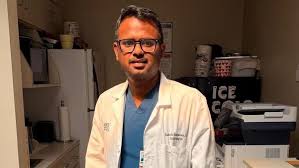
BBC:
Dr Mahesh Anantha is one of the few interventional cardiologists for miles around Arkansas’s Batesville area, a rural pocket of the US.
Surrounded by farmland and a smattering of small industries and banks, the pastoral town with a population of some 11,000 people serves as a hubfor nearby villages and cities, making Dr Anantha’s often lifesaving practice indispensable.
“There is no other medical facility around for an hour or two’s drive, so people rely on us for everything,” he says.
A gold medallist from Madras Medical College in southern India, Dr Anantha is among thousands of immigrant doctors working in small and remote towns in the US.
Twenty-five percentage of doctors providing care in the US are foreign-trained. Recent data shows that 64% of them practise in the vast underserved rural areas where American graduates are reluctant to work, filling a crucial gap in the country’s healthcare system. Many of these doctors are on H-1B visas and some even spend their entire careers on them as they wait for a green card, making them vulnerable to unexpected job losses and long-term instability.
So last month’s announcement by Donald Trump’s administration that it will hike skilled-worker H-1B visa fees for new applicants to $100,000 (£74,359) sparked fear and anxiety among the roughly 50,000 India-trained doctors working in the US. In the days after the move, there was little clarity on how it would affect medical professionals, fuelling uncertainty about their futures, even for those who have spent years building careers and communities in the US.
As outrage spread, a White House spokesperson told Bloomberg via email on 22 September that “the proclamation allows for potential exemptions, which can include physicians and medical residents”. On Monday, US officials announced that the fee “does not apply to any previously issued and currently valid H-1B visas”.
While this clarification may give some relief to doctors who are already working on H1-B visas in the US, there are still questions around whether the steady supply of Indian medical professionals to the US would continue in the future.
The earlier executive order on the visa hike says that the higher fees can be waived if the secretary of Homeland Security establishes that appointing certain workers is “in the national interest”. But the medical industry and groups point out there is no indication that any category of workers, including those in the medical field, has been exempted from this fee.







 Users Today : 338
Users Today : 338 Users Yesterday : 1113
Users Yesterday : 1113 This Month : 22875
This Month : 22875 This Year : 155610
This Year : 155610 Total Users : 513587
Total Users : 513587 Views Today : 552
Views Today : 552 Total views : 1645618
Total views : 1645618 Who's Online : 5
Who's Online : 5